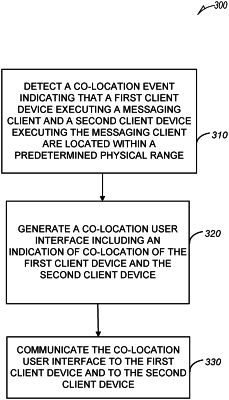| CPC H04L 51/222 (2022.05) [H04L 51/04 (2013.01); H04L 51/046 (2013.01); H04L 51/10 (2013.01); H04L 51/52 (2022.05); H04L 67/306 (2013.01); H04W 4/80 (2018.02); H04W 76/14 (2018.02)] | 20 Claims |

|
1. A method comprising:
in an online messaging system comprising a messaging client and a messaging server, the online messaging system maintaining user profiles representing users of the online messaging system and providing a co-location connection service accessible from a client device via the messaging client:
at the messaging server, designating a first profile from the user profiles and a second profile from the user profiles as paired profiles, the first profile associated with a first client device and the second profile associated with a second client device, the first client device and the second client device executing respective instances of the messaging client and equipped with short range communication sensors that communicate with each other within a predetermined physical proximity range; and
in response to the designating, commencing monitoring a physical distance between the first client device and the second client device based on sensor data obtained by the respective instances of the messaging client from the short range communication sensors of the respective client devices to determine whether to generate a co-location experience of the co-location connection service that modifies a user interface in the respective instances of the messaging client.
|